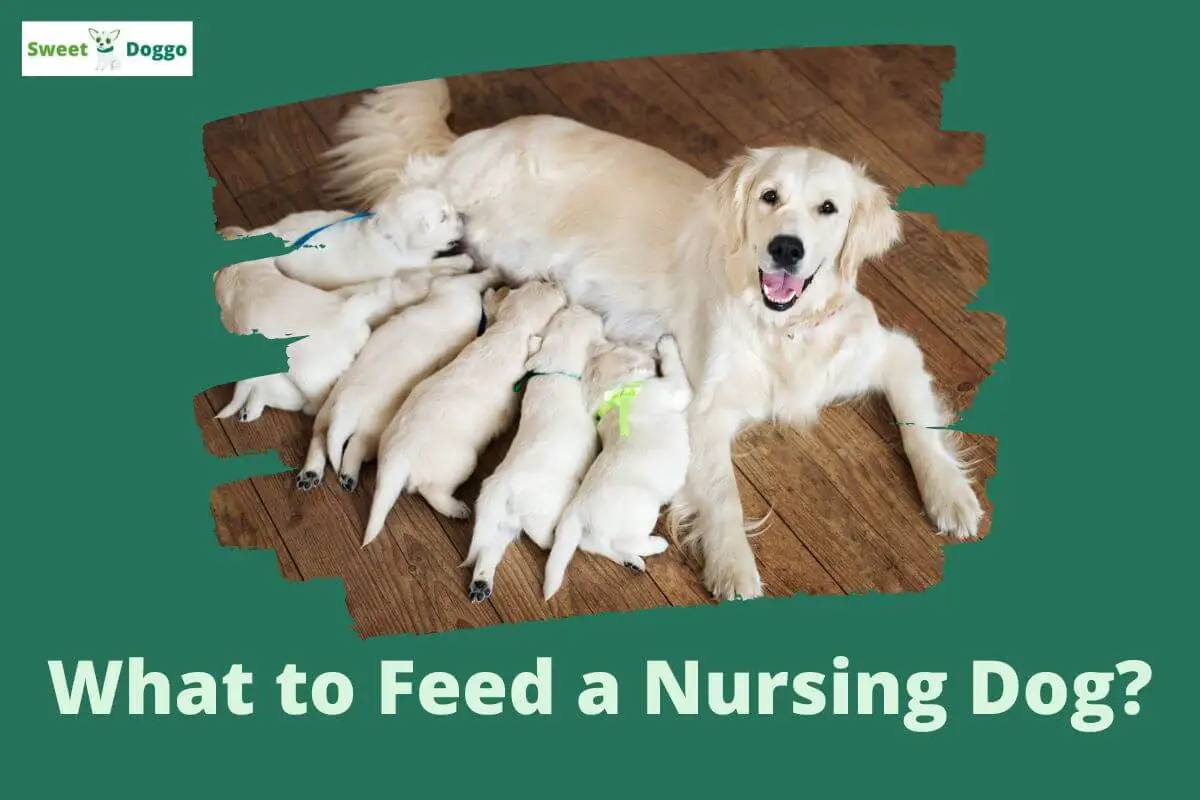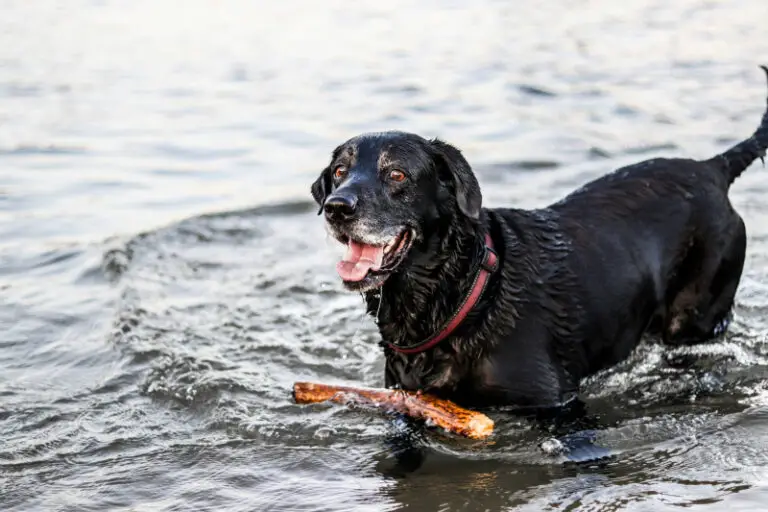The feeding of a recently given birth bitch is something that should not be taken lightly. Providing her with the right food not only has an impact on her well-being but also on her puppies. After giving birth, the bitch will need enough calories and nutrients to support the lactation period.
Many people do not know what to feed a nursing dog in the postpartum period, which is why they end up giving them a poor and deficient diet.
In this quick guide for dog owners, you will find everything you need to know about feeding a nursing dog: type of recommended food, frequency, and size of portions, key nutrients for the lactating bitch, and consequences of inadequate feeding.
Table of Contents
What to feed a nursing dog?
After delivery, it is essential that the bitch is well fed to regain strength and produce the milk that her puppies need. That means that she should eat high-quality food, with a high nutritional and caloric value. In addition, she will need to eat more, even twice the usual amount.
As expected, the mother’s energy needs increase significantly during lactation. Between 3 and 5 weeks after giving birth, a female may require 2 to 4 times the amount of calories that an adult dog consumes.
Something very important to consider is the caloric density of the chosen foods since many times the bitch is not physically capable of eating everything. She needs to maintain constant milk production and a normal weight. That is why it is recommended to promote the consumption of calorie-dense foods.
In general, the proper postpartum diet should meet the following basic requirements:
- Easy to digest
- High in good quality protein
- High power availability
- A significant supply of essential vitamins and minerals
What to feed a nursing dog?
Most vets agree that the best diet for a female dog that has just given birth is puppy food. Formulas designed especially for growing puppies are usually high-quality, rapidly digestible foods with a high protein and fat content.
This is the type of food that can meet the demands of quantity and quality during lactation, not only for the mother but also for the newborn puppies.
Puppy food is higher in fat, protein, and more fortified with vitamins, minerals, and other essential micronutrients.
Look for dry puppy food that is at least 30% protein and 20% fat, or wet food that is at least 7% protein and 5% fat.
The feed can be fed directly, or a powdered formula can be used to supplement their regular food (preferably dry, although it can also be canned). Another alternative is to mix chicken or ground beef with a small portion of white rice and vegetables (all cooked).
Always make sure your diet includes high-quality protein and fat, as well as calcium, zinc, phosphorus, iron, fiber, and plenty of vitamins.
What can be given between meals?
In addition to the main meals, it is necessary to guarantee some type of protein snack. Egg yolk, cheese, and plain yogurt are some of the best options to give between meals.
Another great recommendation is the raw liver, as its iron content helps replenish iron levels after childbirth. The liver is also a good source of protein.
Hydration in a bitch after giving birth
Hydration is as important as food. A female dog needs to drink a lot of water while she nurses her pups. Milk production requires plenty of fluids, so it is essential that the mother has freshwater 24 hours a day.
The owner must be very attentive to the amount of water that their pet drinks, especially if it is being fed a dry diet.
What to do if my dog does not want to drink liquids?
It may be the case that the recently delivered bitch only wants to drink room temperature water, lukewarm water, or cold water. Therefore, it is advisable to offer the liquids at different temperatures to discover which variant she likes the most.
If he doesn’t want to drink water at all, you can give him warm chicken soup, vegetable broth, or a little almond milk (without sugar, flavorings, or other additives), lactose-free goat’s milk, or cow’s milk.
It may interest you: Can Dogs Eat Liver? Types, Recipes, and Contraindications
How much should a lactating dog eat?
A bitch that is just giving birth and nursing her puppies needs to eat twice the amount she normally eats. She sometimes she may need even more, up to 3 times the usual amount of food.
As a guide, it is said that for every puppy she has, the mother requires a 25% increase in her caloric intake. A female dog with 8-10 puppies that used to eat 3 cups of food every day under normal circumstances might need approximately 9 cups a day after delivery.
Another widely used guideline consists of increasing the dog’s food intake by 1½, 2, and 3 times above her usual needs in the first, second and third week of lactation, respectively.
The veterinarian can recommend the food that best meets the demand for protein and fat at this stage.
Now, many female dogs are known to find it difficult to eat that much food and maintain healthy digestive functions. This is why some trainers and veterinarians suggest free-demand feeding for the first 3-4 weeks of lactation.
It is recommended to leave a bowl full of dry food (kibble) for the mother to have access to at all times.
Unless the bitch only has 1 or 2 puppies, there are many advantages to this method. The nursing mother can eat on her own schedule and take smaller portions each time; even puppies can start trying solid food samples as early as 3 weeks of age.
Ideally, you should let your dog eat as much as she wants. This is one time you don’t have to worry about the risk of overfeeding her.
Note. People who feed their pets homemade food should keep in mind that, unlike dry food, it cannot be left in the bowl for hours. Homemade food should be fed fresh, frequently.
How often should I feed a newly delivered bitch?
As mentioned before, a female dog in foal should eat whatever she wants, whenever she wants. However, it is advisable to try to divide her main meals into smaller and more frequent portions. Instead of feeding a large meal 2 times a day, it is better to serve a small, nutrient-rich meal every 2-3 hours.
This keeps your stomach from getting too full and makes it easier to digest food.
It’s always a good idea to check the back of the food bag for the manufacturer’s recommendations if you have a pregnant or lactating dog.
The consequences of an inadequate diet
If the bitch does not receive a good diet after giving birth, then she will have difficulty recovering and feeding her puppies. An undernourished bitch in the farrowing dog will begin to lose weight, lose muscle tone, and may even experience breakage of the coat if malnutrition persists.
By not eating enough calories, your body will use up reserves that can lead to significant weight loss.
Additionally, this is what can happen when a female dog does not eat enough :
- Reduced or non-existent milk production.
- Weak, lethargic, and tearful puppies.
- Death of one or more puppies.
Recommended in sweet doggo: What are the Symptoms of Labor in Dogs? 12 Key Signs
5 Helpful tips for owners
- Place the food near the dog so she doesn’t have to leave her puppies. It is common for the mother not to want to get away from her young after giving birth, being able to go without eating for hours.
- If your dog refuses to eat food immediately after giving birth, opt for high-calorie foods that she can’t resist. You can try treats you know she loves, or add an egg yolk or lard to her food. To make food even more appetizing, you can also dip it in chicken broth.
- Try to get your pet to drink some water as soon as possible to replenish fluids lost during labor. If he doesn’t want to drink plain water, try giving him something more appealing, like some chicken broth.
- For the first 3-4 days, mix the puppy food with the dog’s regular food. This will help her adjust to the new food and decrease the risk of an upset stomach.
- Monitor the mother’s body weight. If you notice that the dog has lost weight, you should increase the amount, as well as the content of fats and proteins in her food. Make sure that she does not lose more than 10% of her original pre-pregnancy weight.
FAQ’s
How fast can a female dog eat after giving birth?
Most bitches lose their appetite just before giving birth, so they may be ready to eat after giving birth. However, this does not usually happen that quickly.
It is normal for the mother to feel too anxious and tense to eat if the puppies are unprotected or crying. Once the female has nursed and is comfortable with her pups, then she can have her first meal from her. It is generally recommended to give him a small amount of water before serving him food.
The first meal after delivery should be light but nutritious. It is recommended to mix the food with broth or warm water and a little cottage cheese. The serving size should be about half of your usual meal.
Now it is important to let her rest with her puppies for a few hours. He may then be offered more food, again half a normal meal. Keeping portions small is best for aiding digestion during the first 12 hours postpartum.
Is it normal that my female dog doesn’t want to eat?
This is completely normal behavior. Bitches do not usually eat right after giving birth. They almost always refuse to eat for hours; some can take around 12 hours to have their first meal. If a dog refuses to eat, her owner can tempt her with the foods she likes best.
If the lack of appetite persists for several days, the veterinarian should be consulted as soon as possible.
What foods or remedies help my dog produce more milk?
Many owners wonder ” what to do” when their dog is not producing milk after giving birth, or when the amount she is producing is not enough to feed a litter of 10 or more puppies.
Although there are no specific foods that magically produce more milk, there are some tips and remedies that, together with a high-quality diet, help stimulate the production of breast milk in female dogs.
1. Milk Thistle
Milk thistle for canine use is one of the most widely used natural supplements to increase milk in lactating bitches. It is usually available in capsules and drops.
2. Fenugreek
Fenugreek capsules also appear to stimulate the production of breast milk in dogs. You can mix the supplement with food, or alternatively, add natural fenugreek.
3. Apricot
Apricot, rich in vitamin C and other vitamins, is said to help a bitch produce more milk. Note. Dogs can only eat small portions of apricots, otherwise, they are prone to diarrhea.
4. Nutritious treats
Treats are an important part of any dog’s diet, especially female dogs that have just given birth. Choosing them well can promote not only milk production but also its nutritional value.
Avoid commercial products that include nutritious fillers; instead, opt for treats that include foods like cheddar cheese, fresh fruits/vegetables, and beef jerky.
Consider that the veterinarian is the only person qualified to approve the use of supplements in dogs. This is even more important if it is a recently given birth bitch.
Lastly, don’t forget the basics.
See also:
What Vegetables Can Dogs Eat? Which ones are prohibited?
Can Dogs Eat Tomato and its Derivatives? Risks and Consumption
5. Plenty of fluids
One of the best ways to ensure a constant supply of milk for puppies is to provide the mother with plenty of fluids. This can be in the form of freshwater or chicken broth.
6. Clear and stress-free environment
A dog that is happy and calm will produce more milk than a stressed, anxious dog. Be sure to set her up in a clean, comfortable area, give her some downtime away from the puppies, and take her out for a short walk around the neighborhood.
Is it advisable to feed a dog with homemade food after giving birth?
Most veterinarians do not recommend homemade food for pregnant dogs or those that have recently given birth. The nursing mother has very specific nutritional requirements, which can be difficult to meet with home-cooked foods.
These foods are not always well balanced and often do not meet the needs of breastfeeding.
If you want to feed a dog a homemade diet after giving birth, consult your veterinarian or nutritionist to develop the most appropriate food plan.
The same is recommended for owners who prefer raw diets for dogs. It is important that the pet receives nutritious food that is easy to digest and absorb.




